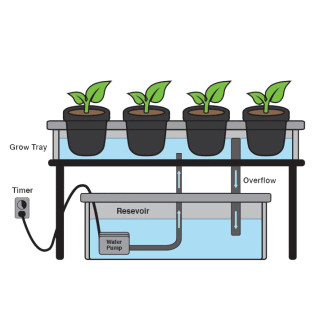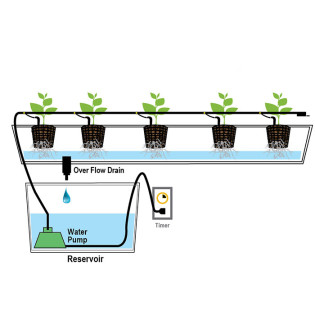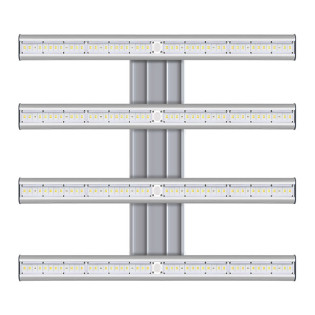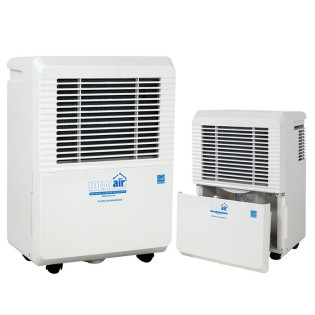
If you are looking for a new food to grow indoors this winter, consider growing hydroponic tomatoes.
This is a very popular food that is actually both a vegetable and a fruit, and most people put their tomato garden on pause during the cold, winter months.
But, you can actually grow this plant year round, all from the comfort of your own home hydroponically!
In this article, we’ll cover everything you need to know about growing tomatoes hydroponically, including pro’s & con’s, which varieties work best, which systems are best for growing hydro tomatoes, and the actual process of growing them.
At the end, we’ll go into detail on common problems people run into, and how to avoid them from the start so you can have a successful first grow!
What is hydroponics?
If you aren’t familiar with hydroponics, this style of growing omits any soil or soil based media. Instead, a completely inert media, such as coco or clay pebbles, is used to anchor the plant roots in place.
Hydroponics involved a concentrated nutrient solution being applied directly to your plants roots, and there are many different methods:
- Deep Water Culture
- Ebb And Flow
- Aeroponics
- Nutrient Film Technique
- Hydroponic Drip
If you want to learn more, check out our complete Hydroponics 101 guide, which covers this style of growing in great detail. Now, let’s get into all the reasons we recommend growers try growing tomatoes hydroponically.
Why you should try growing tomatoes hydroponically
There are tons of benefits of hydroponics that can be applied to tomatoes. From efficiency to simply a fresh new challenge.
But, there are also some drawbacks to this style that you should be aware of. Let’s start with the pros.
Benefits of growing tomatoes hydroponically
The biggest advantage of growing tomatoes hydroponically is that you are able to keep a supply of this food year-round.
When you grow outdoors in soil, you are stuck within the confines of mother nature’s growing season - spring to fall. You miss out on at least 3-4 months of growing, sometimes longer depending on where you live.
You may be thinking, “can’t I just grow soil tomatoes indoors?”. Some of the benefits of growing tomatoes hydroponically vs in soil are all tied back to one thing - cleanliness.
Without the presence of soil, you are going to have a much cleaner indoor growing space. More importantly, however, you are going to be less susceptible to some common soil pests and diseases.
From an efficiency standpoint, you will be able to cut growth cycles drastically in a hydroponic system.
This means you can start eating your hydroponic tomatoes faster than your soil ones!
Your tomato plants will use the nutrients you feed them much more efficiently as well, due to the aeration and concentration of the solution.
Plus, you’ll save a lot of water in the process, as hydroponics is much more water-efficient than traditional growing.
Perhaps the biggest advantage hydroponic tomatoes have over those grown in soil are the yields. Hydroponics can grow much bigger, heavier tomatoes than soil grown. Again, this goes back to the nutrient concentration and root zone aeration.
But, you also get to try something new and exciting. After all, gardening is supposed to be fun, and if you aren’t always challenging yourself, it can become stale over time.
Drawbacks of growing tomatoes hydroponically
There are a few things you need to be aware of if you are going to start your indoor hydroponic tomatoes operation.
For one, it can be a bit pricey to start. The initial investment into a hydroponic system isn’t always cheap, unless you build one yourself.
But, we will give you some recommendations for the best hydroponic system for tomatoes later on, and we’ll include a few reasonably priced options.
Another thing to consider is the steep learning curve of hydroponics. In traditional gardening, you have the soil to act as a buffer for the plant’s roots.
This usually dampens any harmful effects you may see from pH issues, overfeeding, overwatering, etc. But, in a hydroponic system, there is less room for error.
Your roots are exposed directly to the nutrient solution, so any mistakes you make will be magnified.
That’s why it’s so important to constantly be testing your nutrient solution, and keeping a journal to document any irregularities you see.
Hydroponics in general is just a bit more work than soil gardening, so if you are not willing to dedicate much time to your plants, you may want to stick with soil.
But, assuming we haven’t scared you off, let’s talk now about how to get your hydroponic tomato garden started.
Starting Your Indoor Hydroponic Tomato Garden

If you are officially sold on growing hydroponic tomatoes, there are a few things you’ll need.
Obviously you’ll need a hydroponic system, but you may also need grow lighting, nutrients, and a few other accessories to set yourself up for success.
Let’s start with the most important step - choosing a hydro system for your tomatoes.
What is the best hydroponic system for growing tomatoes?
There are plenty of hydroponic systems that will work great for growing tomatoes, but which one is best for you will come down to how large of a garden you want, and your budget.
Growers have used every hydroponic method to grow tomatoes: DWC, Ebb & Flow, Hydroponic Drip, NFT, etc. But, what is the best hydroponic drip system for tomatoes?
Ebb and flow systems

Ebb and flow hydroponics works by periodically flooding the root zone with nutrients, before draining back into the reservoir to let your plants breathe.
This cycle happens throughout the day on a set timer, and is a very efficient growing method.
There are a few different styles of ebb & flow systems here at Hydrobuilder that would work great for growing hydroponic tomatoes.
If you have the money to spend and want to start a decent sized tomato garden, you cannot go wrong with the Botanicare 4’ x 8’ Ebb & Flow System.
This may be a bit big for some beginners, but the Botanicare 3’ x 3’ Ebb & Flow System is all the same quality in a much smaller package, and at a far more budget-friendly price point.
If you know exactly what you want but you don’t see it, you can simply build your own ebb & flow system.
Choose your reservoir and tray sizes, at a stand if you want, and add all the accessories, grow media, and pots you need to get started your way.
Hydroponic drip systems

Another popular system for growing tomatoes hydroponically is the drip system. These are really straight forward, and often used in commercial hydroponics.
Whereas in an ebb and flow system plants are fed through the bottom, by flooding the grow tray, plants are fed through the top in a drip system.
We have a Botanicare 4’ x 8’ Drip System and a Botanicare 3’ x 3’ Drip System, so whether you want a big tomato grow or a smaller one, you can get started with quality components.
Or, you can build your own hydroponic drip system with sizes that work for you. And, you are able to only add what you need!
Choosing grow lights for your hydroponic tomatoes

Since you’ll be growing indoors, you’ll need grow lighting. Your tomatoes should get at least 12-18 hours of light daily.
Unlike certain plants, you don’t need to change the lighting photoperiod as the plants grow. The perfect grow light for you will depend on the size of your hydroponic system, your budget, etc.
In general, LED grow lights are the most efficient and powerful lights there are. But, they do carry the largest investment.
If you want something with lower power but even more efficiency, stick with fluorescents. If you want a cheap, powerful solution, MH/HPS lights will work great.
You can learn more about choosing a grow light setup if you’d like, but don’t overthink this too much!
Choosing hydroponic tomato nutrients
The next thing you need to start your hydroponic tomato garden is a nutrient package.
Hydroponic tomatoes have pretty high nutritional requirements, particularly in the big three - nitrogen, phosphorus, and potassium.
They also need secondary nutrients and micronutrients, especially magnesium.
There are so many different brands out there that it can leave you wondering, which hydroponic tomato nutrients should I go with?
Just like with grow lights, you shouldn’t overthink this. You can check out our guide on the best plant nutrients for some recommendations, but you can’t go wrong with any of the big brands such as Botanicare, Cultured Solutions, General Hydroponics, etc.
Choosing the actual tomatoes you want to grow

Finally, you have all your equipment and supplies. But now you need to consider which varieties of tomato you are actually going to grow. And, are you going to start from seed or cuttings?
There are all kinds of tomato varieties that work great in hydroponic systems. But, let’s just look at it from a more broad level by breaking tomatoes into two categories: determinate vs indeterminate.
Determinate varieties grow like a bush, whereas indeterminate tomatoes grow on a vine. So, which one works best for hydroponic systems?
Since you are growing these tomatoes indoors, and are likely limited on space, you are best off with a determinate variety.
These will be easier to grow, and won’t overtake the room you grow in! Now, should you start from seed or clones/cuttings?
If you can get your hands on them, you’ll definitely be better off starting with cuttings, since it will cut a ton of time off your grow and save you a lot of work propagating seeds. Plus, you’ll need additional equipment to start seeds.
Check out our complete guide to cloning tomato plants if you want to learn how to keep an ample supply of fresh cuttings on hand!
Step by step guide on growing tomatoes hydroponically
Once you have your hydroponic system along with your grow lights and nutrients, you can get your growing environment set up and plant your tomatoes.
Let’s quickly cover the indoor growing environment you’ll need to create for your tomatoes.
The indoor growing environment
If you aren’t familiar with the importance of the atmosphere in your grow room, check out our blog for a detailed guide. But, there are three things you need to control: temperature, humidity, and air flow.
Hydroponic tomatoes thrive in moderate climates, so keep humidity under 40-50% and temperature between 60-75 degrees, if possible.
You should also have some means of air circulation in your grow room, as stagnant air can lead to all kinds of issues.
The best way to create a sealed environment that you can easily monitor and adjust is by using a grow tent.
Otherwise, you’ll likely need to make adjustments to your room to set up a ventilation system.
Daily tasks when growing tomatoes hydroponically

Once you have your tomatoes planted and growing, most of your work will just involve feeding, checking pH, training and pruning the plants. Your feeding schedule will dictate how often you need to change out the nutrient solution, but it will likely be every week or so.
Since you are likely limited on head space, you’ll also want to make sure your tomatoes don’t grow too big. You can limit and direct their growth by training and pruning them.
Assuming you follow our advice and grab determinate varieties, there probably won’t be too much of this to do.
You’ll also need to closely monitor the pH of your reservoir. Tomatoes thrive with a pH between 5.8-6, which is where they are best able to absorb nutrients.
If your pH is out of whack, your plants won’t be able to adequately uptake nutrients and issues will follow.
Other than that, your daily responsibilities will just be to check on your garden and make sure its alive and thriving. Watch for deformities or irregularities, as these are a sign of nutrient or pH issues.
Harvesting your hydroponic tomatoes
If you start with cuttings rather than seeds, your tomatoes will likely be ready to be harvested within 100 days or so. The older your cuttings, the quicker your fruits will bear and ripen.
Actually harvesting the tomatoes is super easy in a hydroponics system. Wait for them to be at their mature green stage, when you see the first blush of red, you can pluck them.
They will continue to ripen once they are plucked.




































